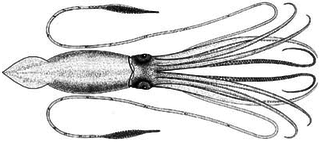
The giant squid is a deep-ocean dwelling squid in the family Architeuthidae. Giant squid can grow to a tremendous size due to deep-sea gigantism: recent estimates put the maximum size at 13 m (43 ft) for females and 10 m (33 ft) for males from the posterior fins to the tip of the two long tentacles. The mantle is about 2 m long, and the length of the squid excluding its tentacles rarely exceeds 5 m (16 ft). Claims of specimens measuring 20 m (66 ft) or more have not been scientifically documented.

Loliginidae, commonly known as pencil squids, is an aquatic family of squid classified in the order Myopsida.
Batoteuthis skolops, the bush-club squid, is the single rare species in genus Batoteuthis, which is the only genus in family Batoteuthidae. The squid is found in Antarctic waters, and reaches a mantle length of at least 350 mm. Some features of this creature are a small head, a long tail and a very peculiar tentacle with six series of suckers on the club.
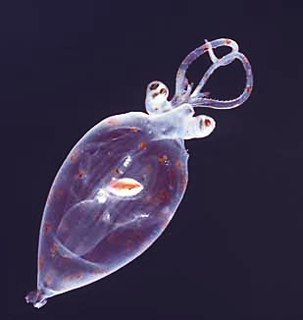
The family Cranchiidae comprises the approximately 60 species of glass squid, also known as cockatoo squid, cranchiid, cranch squid, or bathyscaphoid squid. Cranchiid squid occur in surface and midwater depths of open oceans around the world. They range in mantle length from 10 cm (3.9 in) to over 3 m (9.8 ft), in the case of the colossal squid. The common name, glass squid, derives from the transparent nature of most species. Cranchiid squid spend much of their lives in partially sunlit shallow waters, where their transparency provides camouflage. They are characterised by a swollen body and short arms, which bear two rows of suckers or hooks. The third arm pair is often enlarged. Many species are bioluminescent organisms and possess light organs on the undersides of their eyes, used to cancel their shadows. Eye morphology varies widely, ranging from large and circular to telescopic and stalked. A large, fluid-filled chamber containing ammonia solution is used to aid buoyancy. This buoyancy system is unique to the family and is the source of their common name "bathyscaphoid squid", after their resemblance to a bathyscaphe. Often the only organ that is visible through the transparent tissues is a cigar-shaped digestive gland, which is the cephalopod equivalent of a mammalian liver. This is usually held in a vertical position to reduce its silhouette and a light organ is sometimes present on the lower tip to further minimise its appearance in the water.

Ommastrephidae is a family of squid containing three subfamilies, 11 genera, and over 20 species. They are widely distributed globally and are extensively fished for food. One species, Todarodes pacificus, comprises around half of the world's cephalopod catch annually.

Leachia is a genus containing eight species of glass squids. The genus was formerly divided into two subgenera: Leachia and Pyrgopsis, but is no longer.
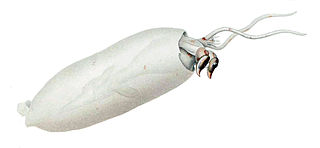
Taoniinae is a subfamily containing ten genera of glass squids.
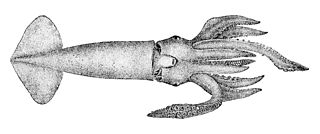
Nototodarus is a genus of squid. Example species in this genus include Nototodarus sloanii, a species sought for human food; in the process of harvesting N. sloanii Australian sea lions are frequently killed, since that marine mammal preys upon this squid species. Furthermore, New Zealand arrow squid, N. sloanii, is an important food source for the endangered yellow-eyed penguin, Megadyptes antipodes.

Alloteuthis subulata, the European common squid, is a species of squid in the genus Alloteuthis and the family Loliginidae.

Martialia hyadesii is a species of squid commonly known as the sevenstar flying squid.
Aggregata is a genus of parasitic alveolates belonging to the phylum Apicomplexa.

Doryteuthis is a genus of squid from the waters of the western Atlantic and eastern Pacific off the coast of the Americas species are the common inshore squids of American waters. Some species are important quarry species for fisheries.
Lolliguncula is a genus of squid from the family Loliginidae from the eastern Pacific and western Atlantic, known as brief squid. The genus is divided into two subgenera Lolliguncula and Loliolopsis. They are rather small squids with a maximum mantle length of 120mm, that inhabit shallow warm seas, although some species have been recorded in areas of low salinity. They are typified by having a short mantle, which is round at the posterior; and fins that are broader than long, but which have no posterior lobes. The males produce spermatophores with a long cement body and they lack a ventral crest on their hectocotylus. Their suckers have square teeth which ring the entire margin or are placed distally. The males do not have enlarged suckers on the left ventral arm. The tentacular club is expanded and contains suckers in four series. The two subgenera differ in the morphology of the hectocotylus.
Richard E. Young is a teuthologist. He is an Emeritus Professor of Oceanography at the University of Hawaii's School of Ocean and Earth Science and Technology.

Stigmatoteuthis is a genus of squid from the family Histioteuthidae. They occur in the Oceans from the tropics south to the temperate seas.
Ornithoteuthis is a small genus of squid, with two species, from the family Ommastrephidae, the "flying squids", the two species in this genus are known as "bird squids". They are relatively small squid, with mantle lengths of around 100–200 mm, highly agile and rather uncommon. Their characteristics that distinguish then from other members of the subfamily Ommastrephinae are that their mantle and fins are drawn out into a narrow tail and that they have a luminous stripe along their midline on the viscera. One species, Ornithoteuthis antillarum, is found in the warmer waters of the Atlantic Ocean and the other, Ornithoteuthis volatilis, in similar areas of the Indo-Pacific oceans, they are closely related and are thought to have been a result of relatively recent speciation.
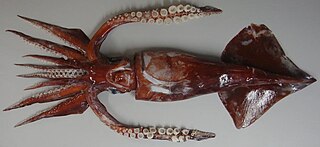
Todarodes is a genus of flying squid from the subfamily Todarodinae, of which it is the type genus. The genus contains five species which are partially allopatric but between them their distributions encompass most of the world's oceans and seas. These squid have a funnel groove with foveola, a hectocotylised fourth arm and tentacular stalks which lack free trabeculae.
Isancistrum is a genus of monogeneans in the family Gyrodactylidae. Unlike most monogeneans which are parasitic on fish or other vertebrates, species of Isancistrum are parasitic on squids (molluscs).














